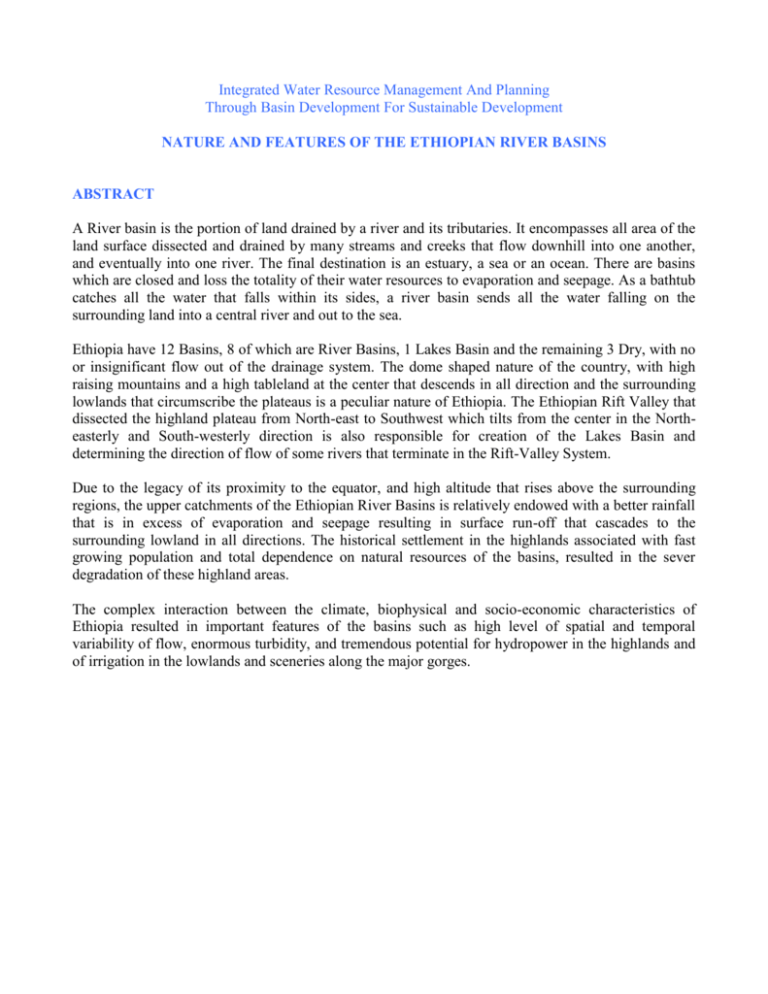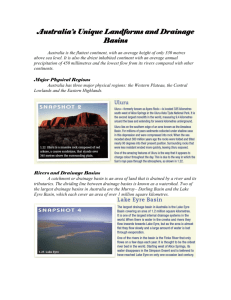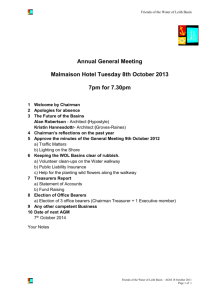Integrated Water Resource management and Planning through
advertisement

Integrated Water Resource Management And Planning Through Basin Development For Sustainable Development NATURE AND FEATURES OF THE ETHIOPIAN RIVER BASINS ABSTRACT A River basin is the portion of land drained by a river and its tributaries. It encompasses all area of the land surface dissected and drained by many streams and creeks that flow downhill into one another, and eventually into one river. The final destination is an estuary, a sea or an ocean. There are basins which are closed and loss the totality of their water resources to evaporation and seepage. As a bathtub catches all the water that falls within its sides, a river basin sends all the water falling on the surrounding land into a central river and out to the sea. Ethiopia have 12 Basins, 8 of which are River Basins, 1 Lakes Basin and the remaining 3 Dry, with no or insignificant flow out of the drainage system. The dome shaped nature of the country, with high raising mountains and a high tableland at the center that descends in all direction and the surrounding lowlands that circumscribe the plateaus is a peculiar nature of Ethiopia. The Ethiopian Rift Valley that dissected the highland plateau from North-east to Southwest which tilts from the center in the Northeasterly and South-westerly direction is also responsible for creation of the Lakes Basin and determining the direction of flow of some rivers that terminate in the Rift-Valley System. Due to the legacy of its proximity to the equator, and high altitude that rises above the surrounding regions, the upper catchments of the Ethiopian River Basins is relatively endowed with a better rainfall that is in excess of evaporation and seepage resulting in surface run-off that cascades to the surrounding lowland in all directions. The historical settlement in the highlands associated with fast growing population and total dependence on natural resources of the basins, resulted in the sever degradation of these highland areas. The complex interaction between the climate, biophysical and socio-economic characteristics of Ethiopia resulted in important features of the basins such as high level of spatial and temporal variability of flow, enormous turbidity, and tremendous potential for hydropower in the highlands and of irrigation in the lowlands and sceneries along the major gorges. 1. INTRODUCTION Ethiopia is a country of diversity. There is tremendous diversity of climatic, biophysical and socioeconomic settings. The climate ranges from equatorial rainforest type climate in the south and southwest characterized by high rainfall and humidity to afro-alpine type on the summits of the Semien and Bale mountains and desert like conditions of the Northeast, East and South east lowlands. Altitudinal gradient ranges from 160mbsl at the Kobar sink in the Dallol Depression where the temperature is in excess of 600c to about 4620masl at Ras Dajen in the Semien Mountains with freezing temperature in most part of the year. The resulting rainfall also varies from about 3000mm/annum at Masha in the Baro-Akobo Basin to barely 200mm/annum along the Ethio-Jibouti and Ethio-Somali Border in the Ogaden and Aysha Basins. The diversity also extends to socio-economic conditions. Economic activities in the country ranges from booming industrialization and modern agriculture in and around Metropolitans such as Addis, Bahir Dar, Mekele and Nazareth to Hunters and Gatherers, Shifting cultivators and Nomadic Pastoralists in the peripheries. The distribution of social and economic infrastructure and amenities is also like wise very variable with some parts of the country relatively well served and others barely reached. 2. WHAT IS A RIVER BASIN? Definition A River Basin is a natural depression in the surface of the land often with lake at the bottom of it It is the entire geographical area drained by a river and its tributaries A drainage basin (also often: watershed, river basin, or catchment): is an area that topographically appears to contribute all the water that passes through a given cross section of a stream A River basin is the portion of land drained by a river and its tributaries. It encompasses the entire land surface dissected and drained by many streams and creeks that flow downhill into one another, and eventually into one river. The final destination is an estuary or an ocean. As a bathtub catches all the water that falls within its sides, a river basin sends all the water falling on the surrounding land into a central river and out to the sea. Generally a river basin with in a country is a hydro-geographical boundary of an area of land that feeds the water it receives to a common river or lake or swamp before it crosses the international boundary or terminates in sea or ocean. How this occurs is the product of the interactions between land and water, particularly the watershed's underlying geology, rainfall patterns, slope, soils, vegetative cover and use. It is a natural boundary that is permanent as opposed to Political or Administrative Boundary that is liable to change with change in governance. 3. RIVER BASINS OF ETHIOPIA The overall land mass of the country is hydrologically divided into 12 Basins. eight of these are River Basins, one Lake and three Dry Basins. Four of the River Basins, Abbay, Baro-Akobo, Mereb and Tekeze are part of Nile River System, flowing generally in the Western direction toward Sudan eventually terminating in the Mediterranean Sea. Five Basins namely, the Omo-Ghibe, Awash, Riftvalley Lakes, Denakil and Aysha can be safely categorized as the Rift-valley system as all of them drain their water in the Great East African Rift-valley. The remaining three, Genale-Dawa, Wabishebelle and Ogaden are part of the Eastern Ethiopian Basin that generally flow in the Southeasterly direction toward the Somali - Republic and then to the Indian Ocean. 4. MAJOR PHYSICAL FEATURES OF THE BASINS OF ETHIOPIA 4.1 Location and Size Almost all of the basins radiate from the central ridges that separate the Rift Valley from the highlands of Ethiopia to all directions out of the country. Basins drained by rivers originating from the mountains west of the Rift Valley flow West into Sudan, and those originating from the Eastern highland flow East into the Republic of Somalia. Rivers draining the Rift Valley Basins System originates from the adjoining highlands and flow North and South of the uplift in the Center of the Ethiopian Rift Valley North of Lake Ziway. Map 1 indicates the location of the River Basins of Ethiopia. There is very big variation in the size of the Basins. The size of a basin in mainly the function of the geological formation. The Wabishebelle Basin is the largest basin in Ethiopian with an area of 202, 220 km2 followed by the Abbay Basin covering an area of 199812km2. The smallest basin is the Aysha Basin with an area of 2223 km2 followed by the Mereb that has an area with in Ethiopia of 5900km2. Table4.1 below shows some physical characteristics of the Basins of Ethiopia. Table 4.1. Important Physical Characteristics of the Ethiopian Basins R.No. Basin Name 1 2 3 4 5 6 7 8 9 10 11 12 type Source Location Bale Highland 4045'N-9045'N 38045'E-45045'E Abbay R West, 7o45' N-12o45' N; Southwest HL 34o05'E-39o05' E Genale Dawa R Bale Highland 3030'N-7020'N 37005'E-43020'E Awash R Central 8030'N-12000'N Highland 38005'E-43025'E Tekeze R North Wollo11040'N-15012'N Highland 36030'E-39050'E Denakil D North Wollo 12o0'N- 1500' N Highland 3900' E- 4200'E. Ogaden D No flow 5030'N - 9044' N 42041'E-45000' E Omo-Ghibe R Central, 4030'N - 9030'N Western HL 3500'E - 3800'E Baro-Akobo R Western 5031'N-10054'N Highland 3300'E-360 17' E Rift Valley L Arsi and 4020'N-8030'N Lakes Central HL 36030'E-39030'E Mereb R Adigirat HL 14003'N-14052'N 37051'E-39027'E Aysha D No flow 10000'N-11000'N 42000'E-43000'E Wabishebelle R Area (km2) 202220 Direction of Flow East Terminal 199912 West (Nile) East Mediterranean Sea Indian Ocean 64380 Northeast West (Nile) NF Terminal Lakes (Internal) Mediterranean Sea Internal 77120 NF Internal 79000 South 75912 West (Nile) South Rudolph Lake (Internal) Mediterranean Sea Chew Bahir West (Nile) NF Swamp Sudan Internal 172259 110000 82350 52000 5900 2223 Indian Ocean in Source: Respective Basin Master Plan Studies HL Highland D-Dry R-River L- Lake NF-No flow 4.2. Topography and Altitudinal Gradient Ethiopia is often fabled as the country of high mountains, flat plateaus frequently cut by deep gorges and wide valleys in the highland and plains in the lowlands. The highlands with very rough terrain are impenetrable making accessibility as well as other development efforts a complex endeavor. The Geophysical setting of the country is generally characterized by highland in the center circumscribed by the lowlands. High raising mountains with flat top and steep sides are common features of the Ethiopian Highland. The lowlands are flat with frequent incision by ravines and gullies. The transition from highland to lowlands is very abrupt with sharp falls and cataracts. Except the Ogaden and Aysha Basins which are totally located in the lowlands, the other basins of Ethiopia exhibit a large altitudinal gradient the highest being in the Denakil Basin. Table 4.2 below lists some topographical features of the Ethiopian Basins. Table 4.2 Important Topographical Characteristics of the Ethiopian Basins R.No. Basin Name 1 Wabishebelle 2 Abbay 3 4 Genale Dawa Awash 5 Source Locality Mt Bale Altitude (masl) 4000 Sekela, West 2000 Gojam Mt. Bale 4300 Highest point Locality Altitude (masl) Galama & 4000 Ahmar Mt Choke 4100 Mt. Batu 4307 Ginchi 3000 - - Tekeze Lalibela 3500 Ras Dejen 4620 6 Denakil - - 4170 7 Ogaden - - 8 Omo-Ghibe Ambo 2800 Abuna Yoseph Divide-line with Awash Mt. Guge 9 Baro-Akobo Illubabor 3000 - 3900 10 - Arsi Mt. 4193 11 Rift Valley Lakes Mereb Zalanbessa 2500 - 3242 12 Aysha - - 1200 - Source: Respective Basin Master Plan Studies Mt- Mount 1900 4200 Lowest Point Locality Altitude (masl) Somali 200 Border Sudan 500 Border Somali 180 Border Terminal 250 Lakes Sudanese 550 Border Kobar Sink 160mbsl Somali Border Rudolph Lake Sudan Border Chew Bahir 400 Eritrean Border Djibouti Border 900 350 395 300 400 Topography and altitudinal settings of a basin are the main functions of geological formations and can clearly reflect the potential for and constraints to the development of the given basin. 4.3 Climate and Hydrology Climate is the function of the location (latitudinal), altitude, angle of the sun, distance from oceans or other water bodies, terrain and the like. The different combination of these factors resulted in the prevalence of diverse climatic conditions in Ethiopia. The major climatic conditions in Ethiopia can be categorized as tropical in the south and southwest, climatic in the highlands and arid and semi-arid in the Northeastern and Southeastern lowlands. Climate has a direct implication on the development of the basin with particular influence on the availability and use of water and pattern of settlement. Hydrology of an area is a direct reflection of the climate, the terrain and other physical characteristics such as porosity, permeability and vegetation cover. Water travels on the surface, underground and in the atmosphere in a well-known cycle. Here emphasis is given to part of the water that run on the surface in the form of streams and rivers or stored in the form of lakes. The very high variability exhibited by the climatic components of the country over time and space is the main reason behind the spatial and temporal variability in the availability of water. The shape, size and other physical features of the River Basin does also contribute to the same. The nature of the river channel, which is a direct function of the relationship between the flow and formation of the channel, governs accessibility to and pattern of use of the waters flowing in the rivers or stored in natural depressions. Table 4.3 indicates important climatic components and water resource potential of Basins in Ethiopia in terms of mean annual run-off, storages in major lakes and impoundments and underground. Table 4.3 Important Climatic Features and Water Resource Potential of the Ethiopian Basins R.No. Basin Name Temperature Rainfall(mm) Evaporation Water resource (oc) (mm) potential(Bm3) Min. Max. Max. Min. Average Average Surface Ground Stored 1 Wabishebelle 6 27 1563 223 425 1500 3.4 2.3 1.1 2 Abbay 11.4 25.5 2220 800 1420 1300 54.4 na 30 3 Genale Dawa <15 >25 1200 200 528 1450 6.0 na 4 Awash 20.8 29 1600 160 557 1800 4.9 0.8 2.2 5 Tekeze <10 >22 1200 600 1300 1400 8.2 na 6 Denakil 5.7 57.3 1500 100 na na 0.86 na na 7 Ogaden 25 39 800 200 400 na 0 na 8 Omo-Ghibe 17 29 1900 400 1140 1600 16.6 1.0 na 9 Baro-Akobo <17 >28 3000 600 1419 1800 23.23 1 na 10 Rift Valley <10 >27 1800 300 na 1607 5.64 na 56.55 Lakes 11 Mereb 18 27 2000 680 na 1500 0.72 0.11 12 Aysha 26 40 500 120 na na 0 na Source: Respective Basin Master Plan Studies .na: data not available 5. SOCIO-ECONOMIC FEATURES OF THE BASIN OF ETHIOPIA The socio-economic features of most of the basins of Ethiopia can be characterized by a simple but strategic terminology of Poverty and Isolation. Poverty expressed both in terms of absolute poverty or through some socio-economic indicators is one of the lowest in the world. The different parts of the basins are physically and psychologically isolated from each other and from other parts of the country. The physical isolation is mainly due to the terrain which is very rugged and impenetrable making accessibility and the development of infrastructure very challenging and the sever shortage of communication infrastructures and systems. The psychological isolation is the reflection of physical isolation in which case citizens have the perception of total isolation from the central government. More than 90% of the inhabitants of the basin are rural and subsistent farmers. The ever increasing population of the basin coupled with absence of alternative source of livelihood resulted in high level of land fragmentation and total dependence on the natural resources of the basin. Land holding size per household barely exceeds 0.5 ha. Most peasants are subsistent farmers with little product to put on the market. Except in some dry basins such as the Ogaden and Aysha, where the dominant mode of agriculture is totally pastoralism, mixed farming in the highland and dominantly livestock production in the lowlands is common feature. Urbanization is very low averaging 10% in most basins. Industrialization and the service sector are not well developed. Settlement pattern is very variable. The general trend is that settlement is very dense in the highlands and sparse in the lowland. Some important socio-economic features of the basins are detailed in the table 5.1 below. Table 5.1 Important Socio-economic features of the Ethiopian Basin R.No. Basin Name 1 Wabishebelle Population '000 '000 1995 2010 5880 9489 Urbanizati Other Social Administration on Indicators GR % Density % Productive Illiteracy Regions Woreda p/km2 Force % 3.9 29 7 49.7 80 O,SN, 76 H,S 2.6 72 7.9 na 74 O,A,BG 162 31.9 9.8 46.7 81.5 O,SN,S 43 2.9 100 10 na na O, SN, 80 A, Af, S, DD, AA 3.7 57.3 10 51.7 84.4 T, A 54 3.9 na na na na A, Af, na T 3.9 na na na na S na 2.9 81.5 7.5-11.7 43.6 na Or, SN 81 2.2 26.7 8.3 49.6 na O,BG,S 72 N,Gm 3 153 7.3 na 79 Or, SN 60 2 3 4 Abbay 14231 22000 Genale Dawa 5100 5100 Awash 11000 14000 5 6 Tekeze Denakil 4720 2068 7 8 9 Ogaden Omo-Ghibe Baro-Akobo 1464 na 6500 10000 2211 3077 10 Rift Valley 7964 12407 Lakes Mereb 437.5 671.8 2.84 11 7550 na 74 5.54 51.4 82 T 11 12 Aysha 56.6 na 3.9 26 na na na S 1 Source- respective Basin Master Plan Studies A-Amhara, AA.Addis Ababa- Af-Afar, BG-Benshangul Gumz, DD-Dire Dawa G- Gambella H-Harari O-Oromia S-Somalia, SN-Southern Nations and Nationalities and Peoples, T-Tigray The most populous basin in Ethiopia is the Abbay Basin. The Abbay Basin is the most important Basin in Ethiopia by most criteria as it contributes about 45% of the countries surface water resources, 25% of the population, 20% of the landmass, 40 % of the nations agricultural product and most of the hydropower and irrigation potential of the country. Population density is highest in Rift Valley Lakes Basin indicating the immense pressure on the resource base. The basin with the lowest population size and density is the Aysha Dry Basin mainly due to its remoteness, inaccessibility, harsh environmental condition and low resource potential and shortage of socio-economic infrastructures and services. Despite the huge productive force in the basins (Age group 15-64), the high rate of illiteracy could be an obstacle to their development. Administratively, most basins drain more than one Regional States. Awash Basin drains seven Regional States and / or City Councils where as the Oromia Regional State is drained by seven different basins. Three of the basins; Ogaden, Aysha and Mereb fall with in one Regional State, Somali and Tigray respectively and the Gambella Regional State falls within one basin ie the BaroAkobo Basin. The discrepancy between the basin boundary which is considered as an appropriate unit for planning and management of water resources and the administrative boundary, within which most decisions of development are made, will be one of the challenges forthcoming with the progress of basin based water resources management approach under implementation. 6. POTENTIAL OF THE BASINS FOR FUTURE WATER RESOURCE DEVELOPMENT Table 6.1. Simple Parameters Indicating the Potential of the Basin R.No. Basin Name Water Resources Irrigation Specific Per-Capital Potential Per capital ha. yield availability ' 000ha (l/s/km2) M3/person 1 Wabishebelle 0.53 578 209.3 0.04 2 Abbay 8.63 3823 1800 0.13 3 Genale Dawa 1.10 1176 1070 0.21 4 Awash 1.41 445 206 0.02 5 Tekeze 3.16 1737 186.9 0.04 6 Denakil 0.42 416 0.00 7 Ogaden 0.00 0 0.00 8 Omo-Ghibe 6.66 2554 90.4 0.01 9 Baro-Akobo 9.70 10507 631 0.29 10 Rift Valley Lakes 3.44 708 131 0.02 11 Mereb 3.87 1646 5 0.01 12 Aysha 0.00 0 0 0.00 Source: Derived from Respective Basin Master Plan Studies Hydropower Firm Energy Per capital GWH KWH/person 7457 55000 9270 5589 8384 26026 19826 1268 3865 1818 508 1776 4004 8967 12240 - 1537 - By virtue of its high potential and less inhabitants, the Baro-Akobo basin has the highest value in most of these indicators. The efficiency of the basin to generate run-off is also the highest when compared to other basins. On the other side of the picture come the Aysha, Denakil, Mereb and Ogaden Basins with less prospect for future development of their water resources. 7. GENERAL FEATURES OF THE BASINS AND THE IMPLICATION ON THEIR DEVELOPMENT High rate of population growth and their total dependence on the basins' resources for their survival and the age-old agricultural practices that is not conservation oriented has resulted in serious watershed degradation which manifested itself in the form of severe erosion and sedimentation. In addition to reducing the productivity of the system, this watershed degradation and the resultant soil erosion has other consequences such as changing the morphology of rivers leading to flooding and change of course, deterioration of water quality, siltation of hydraulic infrastructures thereby reducing the lifespan and capacity of dams and the efficiency of hydropower plants. Remedial measures for this problem can escalate the overall cost required for the development of the basin. Social and economic infrastructures and services are not well developed in rural parts of the basins. This problem is more pronounced in the lowlands of the country. Added to this is the harsh and inhospitable climate of these areas. Contrary to this, most of the land and water resources of the basins are abundant and accessible in this part. More effort is needed to promote development under such circumstances. Major rivers of the country are characterized by big fluctuation in their flow. Optimum use of these rivers requires large impoundments and efficient regulation. The large dams and associated infrastructures that should be erected for this purpose are so costly as to reduce the pace of development of the basins. The terrain of the country is characterized by mountainous highlands circumscribed by flat lowlands. The highlands are sources of major rivers. The transition from the highland to the lowland is sharp and abrupt. The head difference resulting from this steep slope is an opportunity for generation of tremendous hydropower. The lowlands are flat and sparsely populated. Most of the rivers cascading from the highlands merge before reaching or within the lowlands boosting the volume of the overall flow. The potential of these lowland areas for irrigation is enormous. These irrigation potential areas can also benefit from the regulated flow of hydropower schemes upstream. Most of the major rivers of the country cut deep into the protective basalt layer creating awesome and amazing gorges that can attract visitors to the basin. Though the fluctuation of flow and the rugged terrain of the basins do not allow wide use of the rivers for transportation, the few rivers and lakes that are currently serving for this purpose will be reinforced and others also benefit from the regulation effect of planned storage dams. Most of the rivers and lakes of the basins are rich in their fisheries potential. Future development interventions in the basins can boost this potential if planned in a manner that can consider their integration. CONCLUSION The different basins of the country have a diverse and varied resource base. A planned approach to the utilization of these resources in a holistic and integrated manner can change the existing grim picture. These plans should take the specific socio-economic, ecological and resource bases into consideration. The interaction between the different components of the basin and the impact of one on another should also be given due emphasis. In this respect, the proper implementation of the existing Integrated Basins Development Master Plans can help reverse the prevalent watershed degradation on top of improving the socio-economic status of basins.






